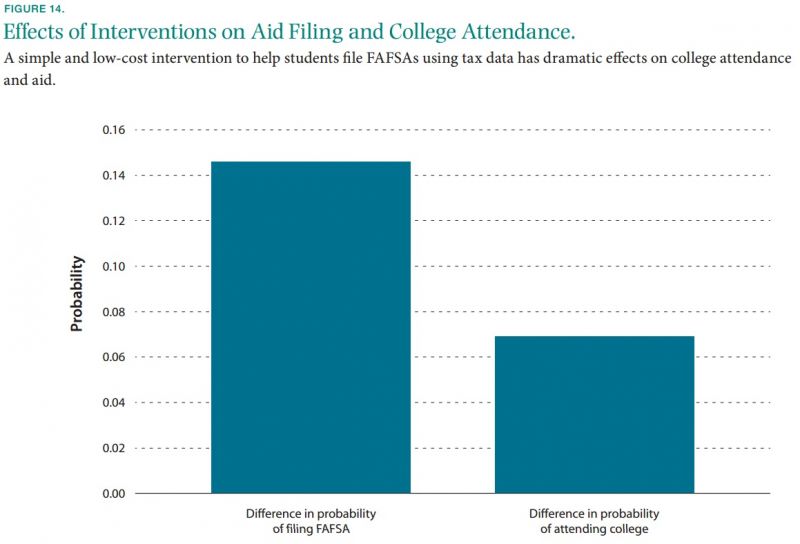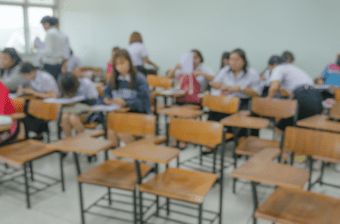The Hamilton Project explores both the condition of education in the United States and the economic evidence on several promising K-12 interventions that could improve the lives of Americans.
Introduction
The Hamilton Project’s mission is advancing opportunity, prosperity, and growth. On both the individual and society-wide levels, a strong public education system enables Americans to achieve those objectives. Indeed, education has historically been the great equalizer and offered students of all backgrounds not the promise of equal outcomes but the prospect of equal opportunity. It has allowed for the growth and development of a thriving middle class, and it has helped make the proverbial rags-to-riches story not just a possibility but a narrative that is inherently American.
Education is a powerful force for promoting opportunity and growth. It is not surprising that an individual’s educational attainment is highly correlated with her income: college graduates generally earn more than less-educated Americans. More alarming, however, the gap between college graduates and everyone else has been getting bigger. Over the past forty years, incomes for graduates have gone up by more than one-third, while incomes for those with only a high school diploma have stagnated; Americans who do not complete high school today actually earn less than similar Americans did in 1970.
Read the full introduction
What might be less obvious is that education is also a significant determinant of many other very important outcomes, including whether individuals marry, whether their children grow up in households with two parents, and even how long they will live.
What’s more, on all of these dimensions, the gap between highly educated and less-educated Americans is getting bigger—in some cases, much bigger. These changes have contributed to the dramatic increase in inequality in American society, and many believe they are laying the seeds for future increases in inequality. These trends are unsettling in their own right but can also undermine our country’s future: high rates of inequality can cause people to lose faith in the shared American project, making it difficult for policymakers to pursue the pro-growth strategies that allow living standards to rise over the long run.
Now, more than ever, it is essential for the United States to increase high school and college completion rates to make our nation more prosperous and to enable Americans to share the bounty of our economy more equally. Despite this impetus, educational completion rates in the United States have stagnated over the past few decades. More than 20 percent of young Americans leave high school without graduating and only one-third have a college degree—figures that are virtually unchanged since 1970. Some of those who leave high school go on to earn GED credentials, but these credentials do not provide the same labor-market boost. The result is that the United States is losing its long-held competitive edge: once the home of the world’s best educated workforce, America has been surpassed by more than a dozen countries in the past thirty years. In part as a consequence, many U.S. families have lower incomes today than their counterparts did several decades ago.
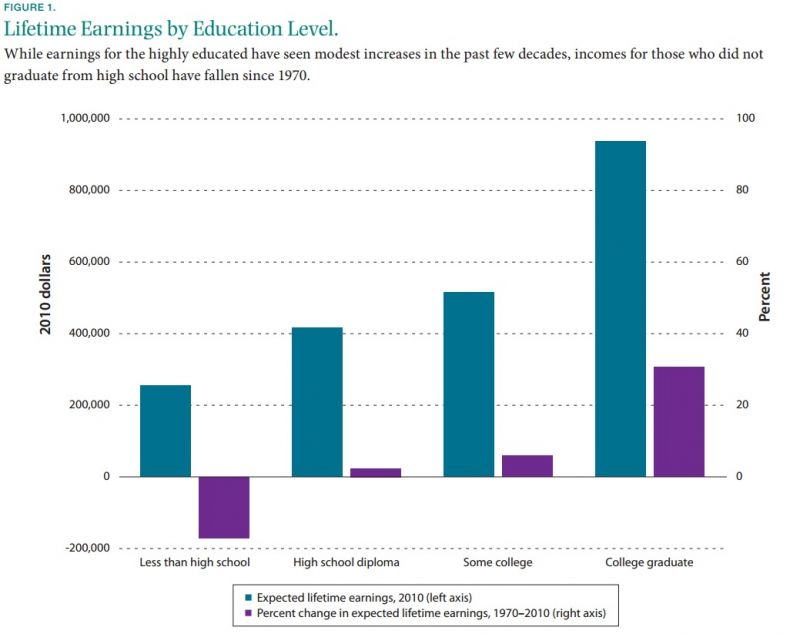
But increasing educational completion rates is only half the battle. As productivity increases in most sectors of the economy, achievement in education—as measured by student test scores—has remained flat. As figure 2 shows, costs of public education continue to grow, while student achievement has not increased. There also are wide variations in studentachievement outcomes across regions, race, and family income, so that many of the students who do remain in school are not receiving an education that will equip them to succeed in an increasingly competitive world.
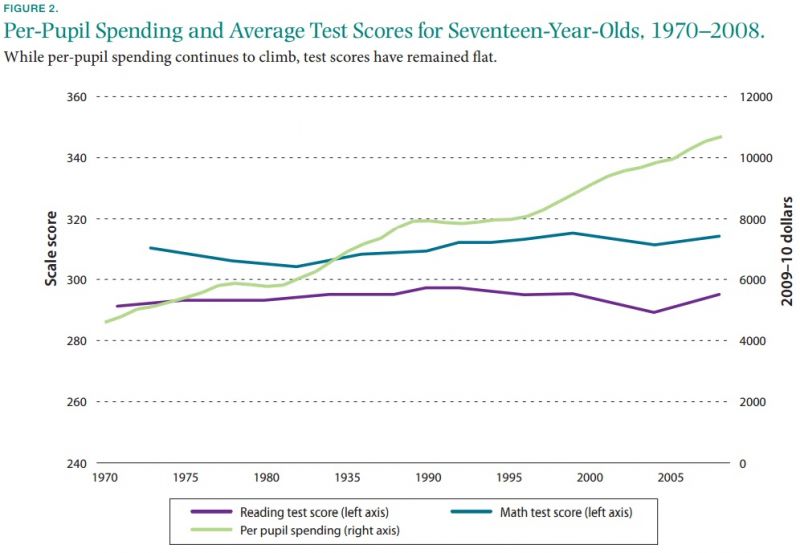
Addressing these challenges is no easy task. It is often difficult to know where to begin to tackle a problem this complex. Moreover, education is a subject that by its nature evokes opinions that are highly personal, emotional, and ideological. In debating public policy, especially education, it is best to start at the basics: What are the facts?
There are, of course, many factors at play in determining educational completion and achievement. From parental involvement to student responsibility to the teachers and principals working within the K–12 education system itself, the issues are manifold. Moreover, not every student begins the race at the same starting line, and although education is a major determinant of one’s lot in life, one’s lot in life is also a determinant of education. For this reason, many of the relationships illustrated below should be treated as evidence of associations between education and various outcomes, rather than necessarily representing education’s causal impacts. Ultimately, the goal of this paper is to present some of the most important economic facts on the state of education in America with a focus on the K-12 school system as the primary policy lever.
This memo proceeds as follows. Chapter 1 includes facts on the disparity in outcomes between more-educated and less-educated Americans, and explains why education matters. Chapter 2 highlights several weaknesses in America’s K–12 education system and points to specific challenges for policymakers to address. Finally, Chapter 3 draws on the economic literature to identify several interventions that thus far have yielded positive results and are promising starting points for education reform.
Chapter 1: Education Improves People’s Lives
Fact 1: Having less education can limit your earnings prospects.
Education is one of the most important determinants of an individual’s earning potential. Not only do less-educated Americans begin their careers earning a fraction of what college graduates make, but those with less education have a very difficult time breaking into the higher tiers of the earnings distribution. As figure 3 shows, almost 80 percent of high school dropouts made less than $30,000 in 2010. Among college graduates, on the other handed, the cutoff for the 80th percentile of earners was around $100,000. In fact, for individuals earning more than $100,000 per year, a college degree is almost a requirement: more than 75 percent have at least a college degree and 90 percent have received some post-high school education. In today’s economy where skills and education are highly prized, having only a high school diploma offers one little chance of breaking into the highestpaying jobs.
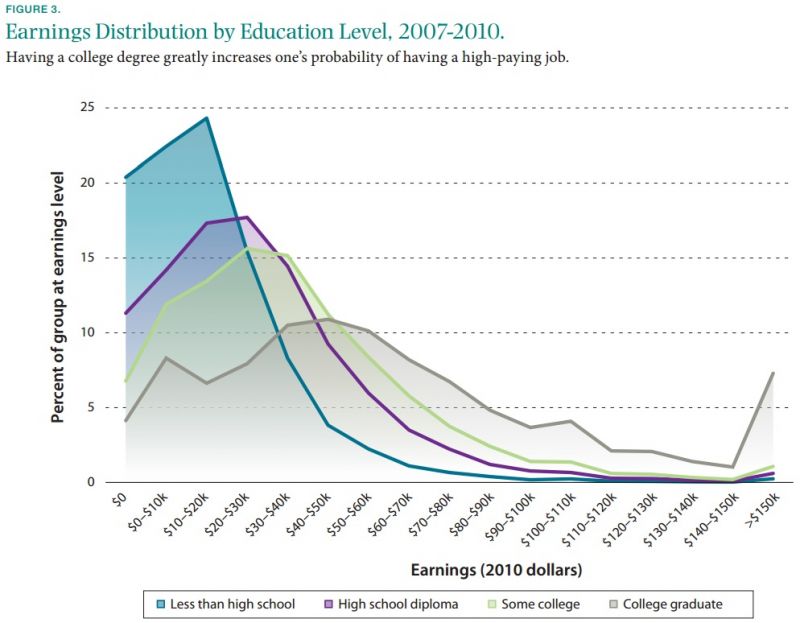
Fact 2: Education benefits individuals and society in general.
Americans without a high school diploma not only earn less on the job, they are also much less likely to hold down a job than are their more educated counterparts. In 2009, almost half of the working-age population without a high school diploma was not employed. By contrast, more than 85 percent of college graduates had a job.
The difficulties that less-skilled workers have finding work have broad effects on their lives and their communities. Of those without a diploma who were not employed, more than half were out of work because they could not find a job, because they were disabled or sick, or because they were institutionalized (mostly in prisons but also in medical facilities). All told, in 2009 more than a quarter of the working-age population without a high school diploma fell into one of those three categories. The lack of good-paying jobs exacerbates the challenges facing less-educated Americans, contributing to higher crime rates and a larger number of working-age adults receiving disability payments, welfare, and other transfers— creating a broader cost to society as well.
One area of growing concern is the difference in institutionalization rates by education category (figure 4). For Americans ages twenty-five to sixty-four, the vast majority of the institutionalized—more than 80 percent—are in prison, with the rest in nursing homes. In the past four decades, the share of Americans without a high school diploma that has been institutionalized has nearly tripled, while the rate for college graduates has remained unchanged. The increasing rates of institutionalization and, particularly, incarceration among the less educated highlight the social costs arising from higher rates of crime among this population—an important concern in and of itself—but they also have broader impacts, as these individuals cannot contribute to the well-being of their families and communities.
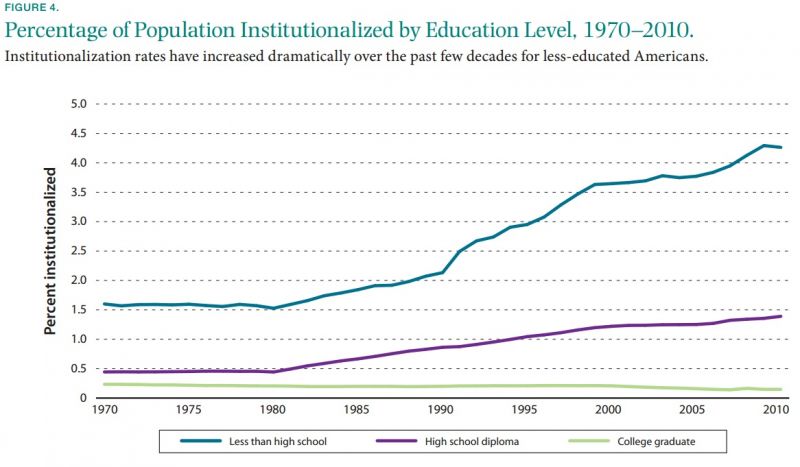
Fact 3: More education increases your chance of being married and raising a child outside of poverty.
Love knows no bounds. The same cannot be said, however, for marriage: college graduates are about 15 percentage points more likely to be married than are those who never attended college. Marriage rates have fallen substantially over the past forty years, but this change has disproportionately affected lesseducated Americans. In 1970, college graduates were no more or less likely to have tied the knot than nongraduates. Today, just over half of Americans without a high school diploma are married (figure 5).
One consequence of this trend is that more children of less-educated individuals are being raised in single-parent households with fewer economic resources to devote to their development. Lower high school graduation rates therefore translate into more children living in poverty. In 2010, more than 38 percent of the 14 million children of mothers who had not graduated from high school lived below the poverty line. A mere 3 percent of the 26 million children of college graduates lived in similar conditions. Being born into poverty puts children at a huge disadvantage. Among other things, they are less likely to do well in school, which creates a vicious cycle where the children of less-educated parents fall farther behind their peers who were born into more-educated families. Parents’ education levels today, therefore, can have profound consequences for future generations.
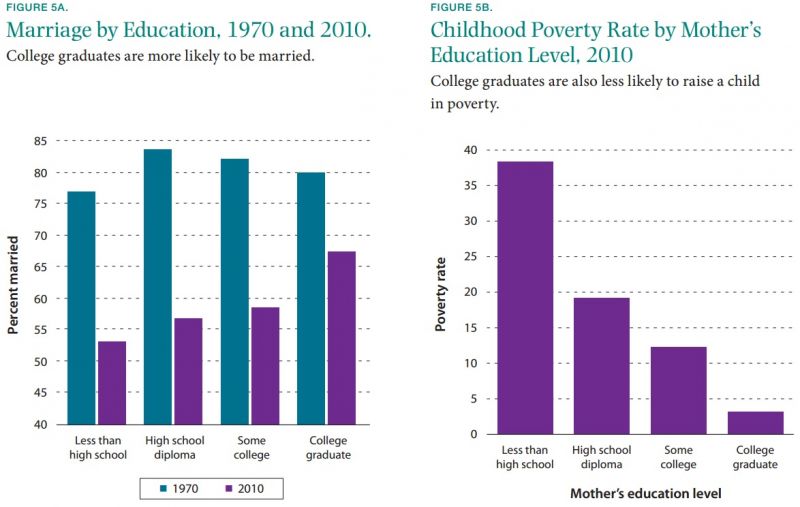
Fact 4: More education can even be th key to a longer, healthier life.
Even in health and longevity, differences between Americans with more and less education are increasing. Although life expectancy has gone up for most people in the past couple of decades, the increase has been largest for people with the most education (figure 6). In contrast, those without a high school diploma have actually experienced decreases in life expectancy. These results are consistent with literature showing causal relationships between education and health behaviors, such as smoking and using preventive care, as well as health outcomes, including depression and obesity (Cutler and LlerasMuney 2006). In part, this relationship is driven by the fact that education leads to higher incomes and more access to health care, but education also works through noneconomic channels. For example, people with more education appear to be better informed about health issues and are more likely to understand and comply with medical instructions and precautions (Cutler and Lleras-Muney 2006).
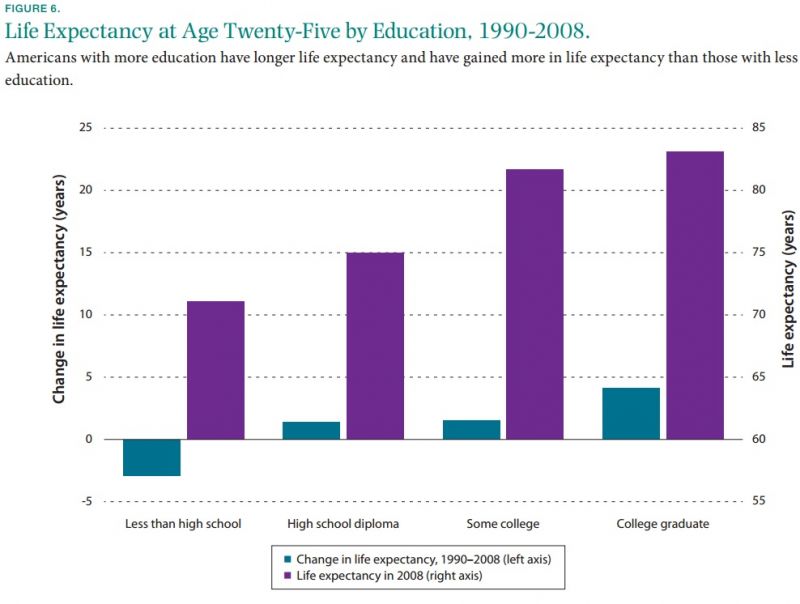
Chapter 2: The United States Is Losing Its Lead in Education
Fact 5: The United States is no longer a world leader in high school and college completion.
Over the past century, education has been a primary contributor to the rising living standards enjoyed by many Americans. But yesterday’s standard of a well-educated workforce is no longer sufficient in today’s increasingly competitive world, and the United States must rise in student achievement to meet the challenges of a globalized, technology-driven economy.
By several important measures, however, rather than advancing we are falling behind. Over the past few decades, college completion rates of the U.S. workforce have stagnated while increasing in the rest of the world. One way to illustrate this is to look at the levels of education among young workers compared to older workers (figure 7). Whereas America’s older workers were among the best educated in the world—reflecting the rapid advance of educational attainment in the United States—today’s younger workers have been surpassed by increasingly welleducated workers from other industrialized countries. Indeed, our young workers now rank fifteenth in college completion rates in the OECD. The United States also trails other countries on other measures of educational achievement—high school completion rates for young Americans have fallen to eleventh place globally (OECD 2011) and we are now twenty-fifth on international assessments of math and rank fourteenth in reading (Fleischman et al. 2010).
Indeed, the consequences of our failure to further increase our levels of education are already emerging: for the median American two-parent family, earnings increased 23 percent from 1975 to 2009, but hours worked increased 26 percent (Greenstone and Looney 2011). A failure to reverse this trend is likely to exacerbate America’s declining competitiveness. One approach, outlined by Derek Messacar and Philip Oreopoulos of the University of Toronto in a new discussion paper for The Hamilton Project, “Staying in School: A Proposal to Raise High School Graduation Rates” (2012), combines increases in the compulsory-schooling age with supports for at-risk students. Such a program could reengage students and thus help more students graduate from high school.
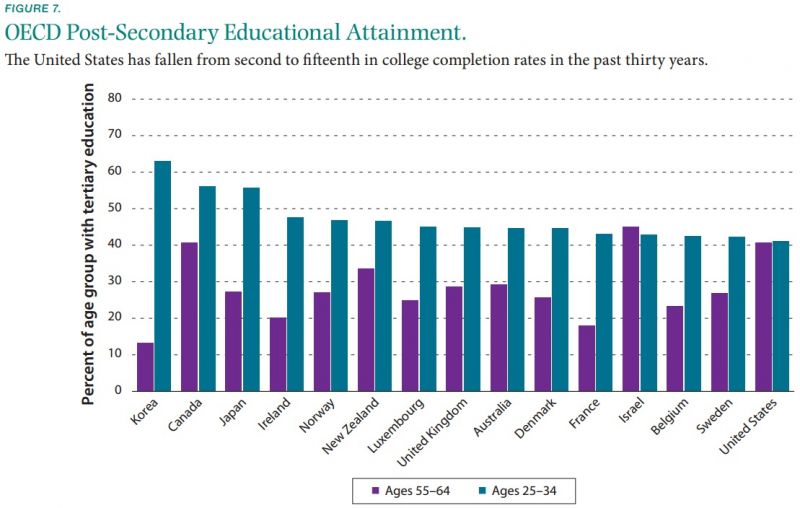
Fact 6: Stubborn racial differences in educational achievement remain among Americans.
Public education is the great equalizer in America, providing opportunities for all students to take a first step onto the ladder of economic opportunity. But some students arrive at school less prepared and fall farther behind during school, resulting in a society where opportunities are not equally shared and the full potential of the labor force is not realized.
For instance, the data show a clear achievement gap between black and white students. As shown in figure 8, researchers have found that there is no significant difference in cognitive ability between black and white nine-month-olds after taking observable characteristics into account (Fryer and Levitt forthcoming). However, based on studies by Fryer and Levitt (2006), when black students enter school in kindergarten or first grade, they are already achieving at lower levels than their white counterparts on standardized assessments. The gap in educational achievement widens as children get older, with black students falling steadily behind. Although the gap is smaller when socioeconomic differences are taken into account, observable differences in income, region, and other socioeconomic features do not explain the gap.
These gaps reflect a mix of factors, but there is compelling evidence that variation in school quality is part of the cause (Hanushek and Rivkin 2006). This variation in school quality and its impact on achievement runs counter to the notion that all Americans have equal opportunities to succeed.
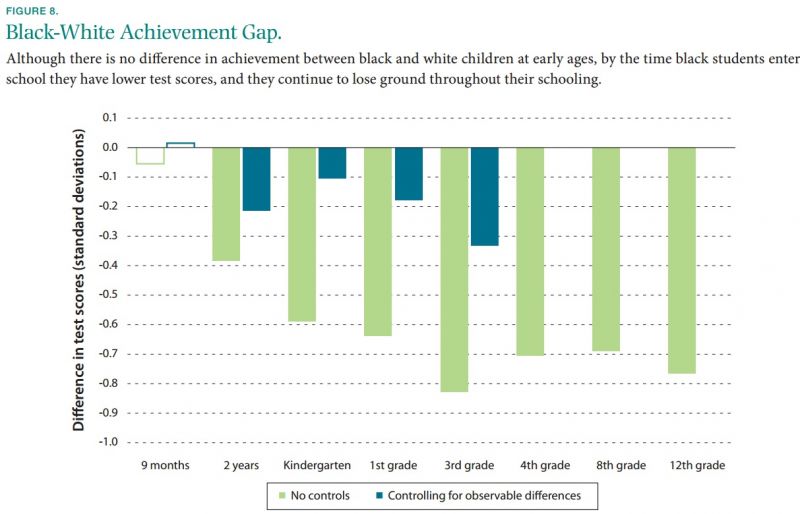
Fact 7: Education lages behind other sectors in innovation investments.
Over the past three decades, average math and reading test scores of American seventeen-year-olds have been flat, while per-pupil spending has almost doubled. This partially reflects that schools must compete to hire college-educated teachers in a labor market where well-educated workers command higher and higher salaries.
But it also indicates that innovation and increases in productivity have occurred faster in the broader economy than in the field of education. In other words, education has faced a relative innovation deficit. Overall, the United States spends about 3 percent of its total expenditures on R&D, with that figure reaching as high as 23 percent in pharmaceuticals (figure 9). In education, however, only 0.2 percent of expenditures are spent on R&D.
Increasing productivity and innovation requires identifying promising approaches, testing those approaches rigorously, and disseminating results. In a new Hamilton Project discussion paper, “Harnessing Technology to Improve K–12 Education” (2012), Aaron Chatterji of Duke University and Benjamin Jones of Northwestern University put forward a proposal for making the marketplace for education technologies transparent, thus unleashing the powers of innovation in education.
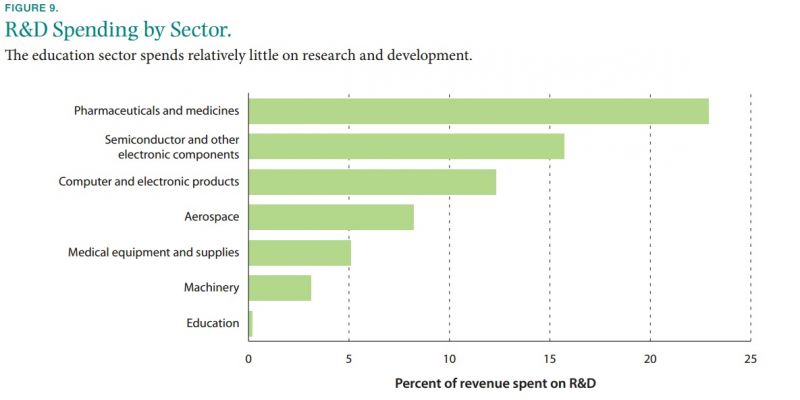
Fact 8: Parents with more education are able to invest more in their children.
Differences in education can be transmitted across generations, because parents who have more education also have more resources to invest in their children. Moreover, these investment gaps are getting larger. Aside from being able to provide greater enrichment opportunities through tutors, summer camps, and extracurricular activities, parents with more education spend more time with their children—including time spent taking care of the child’s basic needs, educational activities, playtime, and travel to and from these activities—than parents with less education. This is true for working and nonworking women, as shown in figure 10, and the same pattern holds for working men (Guryan, Hurst, and Kearney 2008).
Parents naturally want to give their children every advantage possible and work hard to do so. However, the trends illustrated in figure 10 have troubling implications for intergenerational mobility. In the early 1970s, families in the top 20 percent of theincome distribution spent about four times more on enrichment expenditures, such as books, high-quality childcare, and private schooling, than families in the bottom 20 percent. By the mid- 2000s, this ratio of spending was almost seven to one (Duncan and Murnane 2011). If investments in children are increasingly unequal, then equality of opportunity—the promise of the American Dream—is threatened. Students with fewer resources are especially prone to fall behind over the summer, because more-advantaged students continue educational activities during those months.
In a 2006 Hamilton Project discussion paper, “Summer Opportunity Scholarships: Narrowing the Skills Gap,” Molly Fifer and Alan Krueger of Princeton University offered a proposal to fight summer learning loss among disadvantaged students by expanding access to summer schools and other enrichment programs.
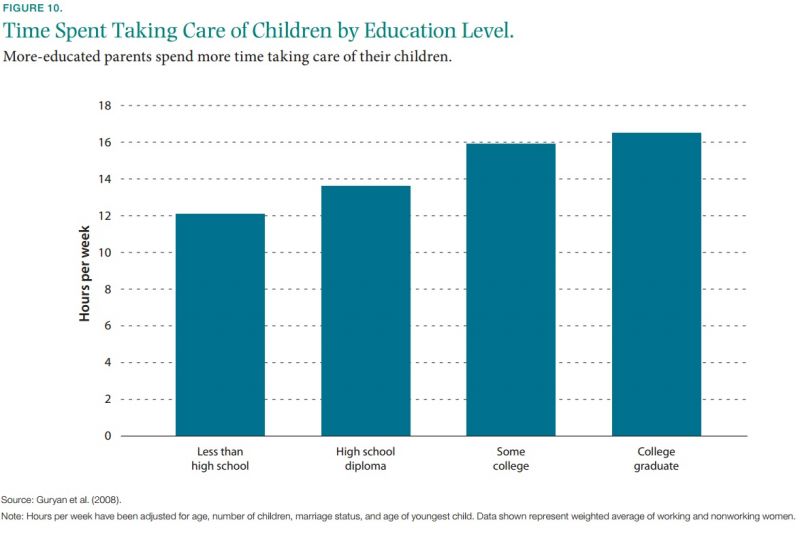
Chapter 3: There Is Promise for Raising Educational Attainment
Fact 9: Better teachers matter, even more than you might think.
Great teachers leave indelible marks on their students, nurturing their talents and helping them discover their passions. They help students develop social skills and foster self-confidence. But while many of their most important impacts are intangible, studies show that some are readily quantifiable.
New research attempts to uncover just how strong these effects are, even many years down the line and in outcomes that are more tangible than test scores (Chetty, Friedman, and Rockoff 2011). Using estimates of “teacher value-added,” a measurement of a teacher’s impact on her students’ test scores, Chetty and colleagues were able to isolate the influence of having a better teacher on a host of outcomes.
Employing the authors’ results, we estimate the impact by comparing the consequences of having a teacher in the 75th percentile of value-added with having a teacher in the 25th percentile. On average, students in a class with the higher valueadded teacher for just one year experience the following benefits:
- The net present value of their lifetime earnings is nearly $6,400 greater.
- They are 1.7 percent more likely to attend college.
- Females are 1.7 percent less likely to have a child as a teenager.
It should be stressed that these improvements occur from just one year of having a better teacher. The long-run impacts of having better teachers throughout a child’s education are likely significantly higher.
A 2006 Hamilton Project discussion paper by Robert Gordon, Thomas J. Kane, and Douglas O. Staiger, “Identifying Effective Teachers Using Performance on the Job,” explored variation in teacher quality and proposed that the federal government support states in developing measures of effectiveness to be used in tenure decisions.
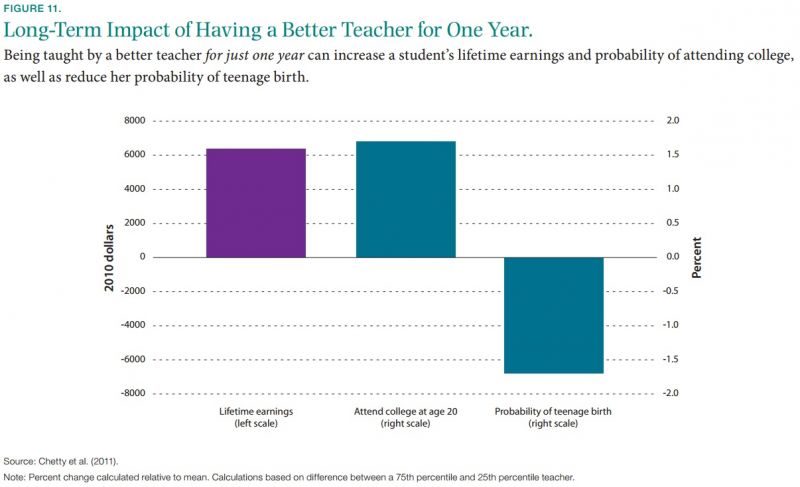
Fact 10: Some charter schools show dramatic improvements in student achievement and may provide lessons for the broader education community.
Improving primary and secondary education in the United States will require action on multiple fronts, and we may draw some lessons from successful charter schools. Publicly funded but more autonomous than traditional public schools, charter schools have greater space to innovate. While not all charter schools are successful, some have shown remarkable results and could offer guidance for public school systems.
Recall from fact 6 that evidence shows that black students start school at a significant disadvantage relative to white students. Charter schools, such as those in the Harlem Children’s Zone, often serve underprivileged and minority students, where the black–white achievement gap is especially salient. For a student who shifted from a public school (in Harlem) to the Children’s Zone, the black-white achievement gap in math would be erased in just three years—a remarkable outcome (Dobbie and Fryer 2011). KIPP (Knowledge Is Power Program), the largest charter network in the country, has also shown dramatic results (figure 12).
But as the results of broader studies on charter schools demonstrate, the impacts can be inconsistent. For example, New York City charter schools as a whole do not perform as well as those in the Harlem Children’s Zone, and national charter schools seem to perform no better than traditional public schools on average. In new work for The Hamilton Project, Roland Fryer of Harvard University and EdLabs tries to determine what practices make charter schools successful and then offers suggestions on how to apply those lessons in traditional public schools.
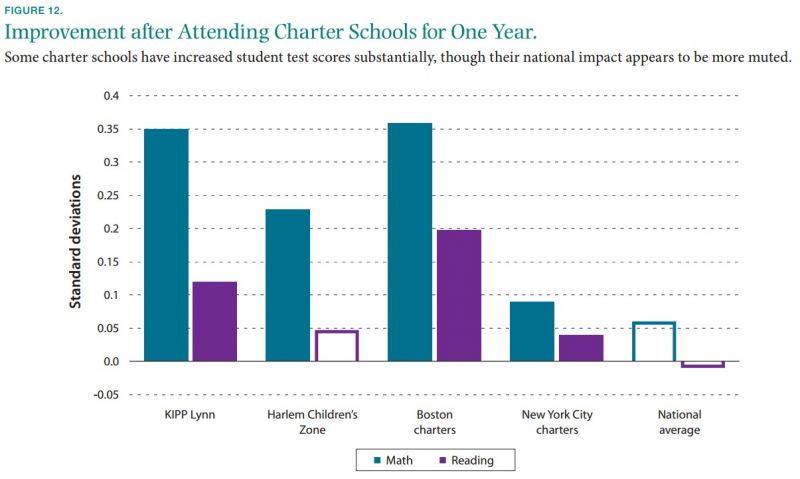
Fact 11: Small-scale interventions also present opportunities for raising student achievement.
There is no single solution to the many problems with America’s education system. While big changes are often the topic of discussions around K–12 education, there is also room for smaller interventions. Some of these results are less dramatic, but they offer real progress toward bettering student outcomes.
For example, incentivizing students to read can significantly increase reading scores (Fryer 2011). Organizing schools to use a K–8 structure instead of middle schools also can improve test scores, since 6th-8th grade students seem to learn better in K–8 schools (Lockwood and Rockoff 2010). Later start times can boost achievement as students may get a more healthy night of sleep (Edwards forthcoming); after-school enrichment programs can also be effective (Lauer et al. 2006). Lastly, research shows that smaller class sizes substantially increase student outcomes. A 2011 Hamilton Project discussion paper by Brian Jacob of the University of Michigan and Jonah Rockoff of Columbia University, “Organizing Schools to Improve Student Achievement: Start Times, Grade Configurations, and Teacher Assignments,” outlines cost-effective organizational changes that build on this economic evidence to improve student achievement.
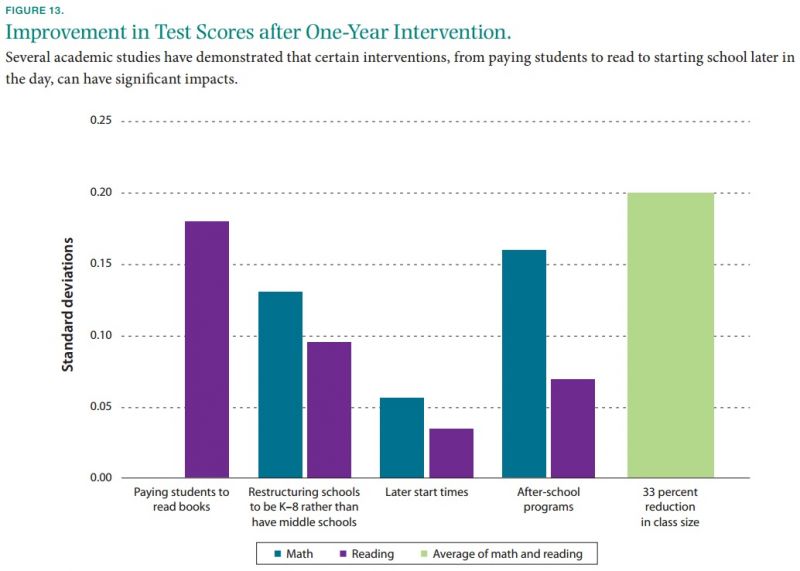
Fact 12: More information and greater transparency in our education system could go a long way toward improving outcomes.
An important puzzle in American education is why high school and college completion rates have stagnated (especially for men), when the benefits of getting more education have increased. A similar question has emerged from other research showing that well-qualified, low-income students tend not to apply to colleges where they would be competitive (Avery et al. 2006; Pallais and Turner 2006).
One emerging answer is that access to information matters. For instance, recent experiments suggest that targeted informational efforts could increase matriculation for academically talented but economically disadvantaged students (Avery et al. 2006; Pallais and Turner 2006). Similarly, the complexity and opacity of the financial-aid process appears to discourage students from applying to college. Figure 14 shows the results of a recent study, in which families were provided with assistance in filling out federal-aid applications while filing their taxes. This basic assistance significantly increased FAFSA applications and college attendance (Bettinger et al. 2009). These interventions also show that a significant portion of students are discouraged from going to college by the need to fill out forms, which have small cost relative to the payoff of college. In a previous Hamilton Project discussion paper, Susan Dynarski and Judith Scott-Clayton argue that simplification of the current system of federal grants and aid could push more students on the margin to pursue college (2007).
